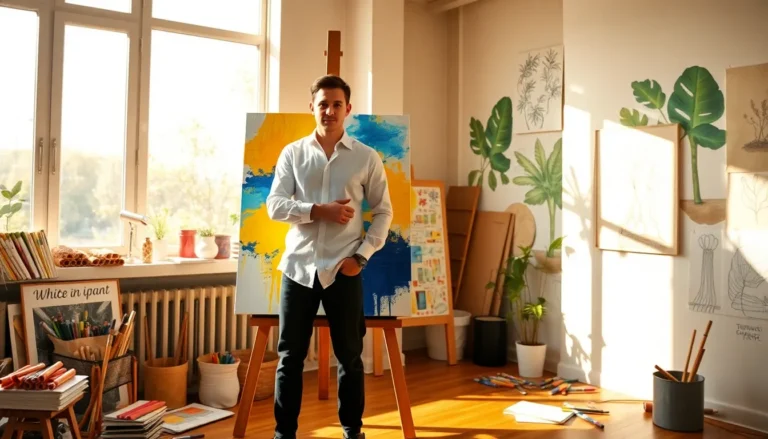Table of Contents
ToggleImagine transforming your backyard into a dazzling oasis without ever lifting a shovel. Computerized design has made this dream a reality, revolutionizing landscaping in ways that would make even Mother Nature raise an eyebrow. With cutting-edge software, landscapers can create visually stunning layouts, ensuring that every flower bed and patio paver is perfectly placed. In this lively exploration, let’s investigate into how technology, humorously dubbed ‘the magic wand for gardeners,’ has reshaped our outdoor spaces for the better.
The Evolution of Landscaping Techniques

Landscaping has come a long way since the days when creativity meant piling up stones and scattering wildflowers around. Early techniques relied heavily on manual labor and intuition. Craftsmanship was important, yet often limited by one’s artistic vision or physical capabilities. Fast forward to today, and computerized design has taken the helm, steering this art towards a future brimming with possibilities.
Dynamic software programs like AutoCAD and SketchUp allow landscapers to translate their vision into digital plans, making a variety of ideas visible before a single blade of grass is cut. This evolution has not just enhanced aesthetics: it has made landscaping more scientifically informed, integrating environmental considerations into the design process.
Plus, the interaction between landscapers and clients has evolved significantly. Presentations can now be interactive, allowing clients to visualize changes in real-time. References to ancient practices are still apparent, but modern landscaping is now shifting with other advancements, such as drone technology, tap into aerial views to gather insights. The evolution from crude sketches to immersive 3D renderings is a monumental leap in how landscapes are designed.
Benefits of Computerized Design in Landscaping
Computerized design has mulled its way into landscaping with a hefty arsenal of benefits that can help any landscaper, novice or expert, simplify their craft.
Enhanced Visualization and Planning
The ability to visualize designs instantly is where computerized landscaping shines. Clients adore seeing what their future outdoors will look like before any plants are even bought. No more guesswork: designers can present lifelike 3D models, vivid colors, and realistic textures in the click of a mouse. That hedge they imagined? Now it can be placed and viewed in context. With virtual reality becoming a reality, design walkthroughs are now available, allowing clients to step into their future backyard. They can move around their digital garden as if it were real, a transformative experience that redefines how decisions are made.
Efficiency and Precision in Design
Time is money, as they say, and computerized design saves an abundance of both. Designers can draft plans more quickly, allowing for quick revisions based on client feedback. Choosing plants and materials can be a drag, but with software built to recommend suitable options based on sun exposure and soil type, even that process becomes a breeze.
Also, computerized designs help precise measurements and detailed elevations. This precision reduces margin for error tremendously, minimizing wasted resources and sparing landscapers the headache of correcting mistakes that plague traditional methods. Efficiency is maximized by minimizing the space for guesswork and lengthy discussions.
Sustainability and Resource Management
One of the standout perks of computerized design lies in its commitment to sustainability. Compared to traditional landscaping methods, computerized designs allow for more environmentally conscious planning. Computerized systems can assess the ecological impacts of proposed designs, helping landscapers make informed choices that minimize harmful effects.
Besides, by utilizing software that includes features for optimizing water usage and energy efficiency, landscapers can create designs that align with sustainable practices. For example, they can simulate rainwater harvesting systems, ensuring that landscapes use natural resources thoughtfully.
Resource management further extends into plant selection, where computerized programs suggest native and drought-resistant species suited to the local climate. This not only enhances the landscape’s beauty but also reduces maintenance costs and environmental impact. And let’s be honest, a garden that thrives with minimal fuss is something worth celebrating.
Case Studies of Successful Computerized Landscape Designs
To illustrate the profound impact of computerized design, let’s take a stroll through a few successful case studies. Consider a community park redeveloped in Austin, Texas. Designers utilized computer software to model various layouts, incorporating walking paths, picnic areas, and natural habitats. The result? A stunning green space that serves the community while promoting biodiversity.
In another instance, a private estate in Northern California embraced landscaping technology to develop a breathtaking balance between serenity and sustainability. The digital design mocked up drought-resistant landscaping further enhanced with computer-analyzed irrigation systems. Homeowners proudly shared their sustainable oasis, which required minimal upkeep while showcasing a vibrant palette of drought-tolerant flowers.
These cases demonstrate the transformative powers of computerized design. When it’s applied with creativity, the outcomes can redefine landscapes from mundane to magnificent.
Future Trends in Computerized Landscaping Design
Looking ahead, the future of computerized landscaping design gleams with possibilities. As technology evolves, so will the tools available to designers. Artificial intelligence is on the cusp of simplifying the design process even further. Imagine AI-powered programs that analyze existing landscapes and suggest enhancements to boost aesthetic appeal or functionality.
Integration of augmented reality might allow clients to view potential designs on-site through their smartphones. This kind of merging of the digital and physical realms could pave the way for a future where landscape design is as simple as swiping left or right.
Also, collaborative platforms may emerge, enabling designers, clients, and horticulturists to work asynchronously on projects. The best part? As designers create, clients can witness changes unfold in real-time, assuring satisfaction.
As the technology continues to evolve, who knows? Soon landscaping might just involve waving a wand to bring digital blueprints to life in a heartbeat.




